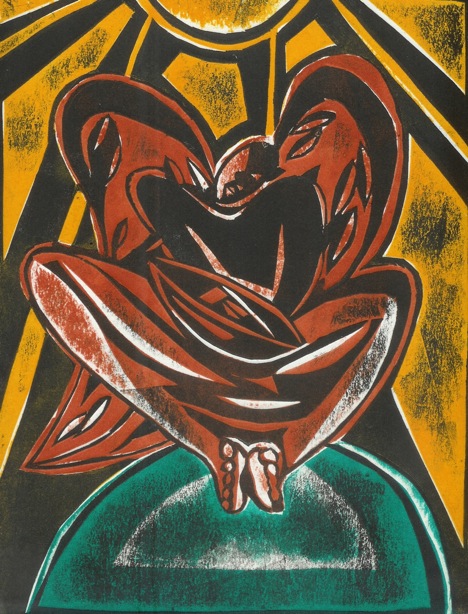Our guest post this week is by Mavhu F.W. Hargrove, a first generation Zimbabwean American who writes and teaches in Washington, DC.
I had always thought of the skies as having significant influence on African cultures other than my own, and so had never thought of my own people’s connection to astronomy until I was asked by Rujeko Dumbutshena, a dancer, visual artist and a friend from childhood to write some poetry specifically for the African Cosmos: Stellar Arts exhibition.
Rujeko brought me, a writer, and Farai Malianga, a musician and composer, together so the three of us could use our different art forms to tell a story. We decided to begin the piece with an African creation story. I grew up in suburban Zimbabwe of the eighties and nineties, and know some Shona stories– but because I am from a Christian household, I had never read or been told a creation myth outside of Adam and Eve. I toyed with the idea of writing a Dogon creation myth, but I did not feel that I knew enough about them. The Yoruba were my next option as it was easy to find many versions of their creation stories that directly link the heavens and the earth.
These were the obvious options, but with all three of us being not only Zimbabwean but Shona, it did not make much sense to tell a story that was not our own. I was able to find various versions of this Shona creation story:
God created Mwedzi (the moon) in a deep pool of water. The moon begged to be allowed to live on land. Once on land, Mwedzi was lonely, so God sent Hweva (Morningstar) down to become his wife but warned that after two years he would have to return her to the sky. Hweva stayed with Mwedzi and gave birth to all the vegetation on earth. After two years, a reluctant Mwedzi sent her back to the sky.
Mwedzi became lonely again, so God sent him Venekatsvimborume (Eveningstar) and again told him that she must return to the sky after two years. Venekatsvimborume stayed with Moon. She gave birth, first to herbivores and birds and then to boys and girls. After two years God asked the Mwedzi to return her. Mwedzi refused. On the next day Venekatsvimborume gave birth to lions, scorpions and other predators.
The Shona creation story made immediate sense to me. The Shona have a deep reverence for natural bodies of water -man is created in a deep pool of water. Dzivaguru is one of the praise names used for the creator and the literal translation of the word is “deep pool of water.” Dzivaguru is also the name of one of Zimbabwe’s most important shrines.
So I now had our story and characters, and only needed a place to imagine as the “set” of the poetry. We all felt the oldest place in our history, Great Zimbabwe– a former capital city that existed in the 12th -14th centuries– would be the perfect setting for a creation story. I came across a news article that spoke of the monoliths at Great Zimbabwe lining up with Orion at sunrise on the shortest day of the year. It all came together for my purposes- a man waiting for the return of his loved one would spend his time building structures that celebrated the time of her return.
Orion reaches out to the pyramids
Venus whispers through the houses of stone
Where mwedzi the moon waited patiently, marking day and night
Great Zimbabwe was a regular vacation spot for my family. Even if we contemporary Zimbabweans have forgotten the original meanings behind the structures of Great Zimbabwe, there is still a sense of being connected to something universal and much larger than yourself when you are there.
Monuments ruined
Lost in our amnesia
Stars still light our shrines
My inner feminist did not allow for me to write something in which the female characters are only referenced by their relationship to men. I wanted to let Hweva and Venekatsvimborume tell me who they were. So I looked up the morning star and the evening star and found that they are not stars at all but the planet Venus, the Roman goddess of love, appearing at different times of day. Morning star and evening star were the same woman, the first woman, doing what women still try to do, balance the happiness of their families with their own needs and goals.
The forest haired boy mourns Morningstar silently
But his father calls for her return
moon lit
She returns
As Eveningstar
The forest haired boy mourns Morningstar silently
Earth bound to her husband’s voice his mother marks night and day.
Venekatsvimborume
Her sons, predators
Nature’s executioners
Granting death, with grace.
Creation stories help us to further understand ourselves, our relationships to each other and our place in the universe. As I continue to work on our performance piece, and watch Rujeko and Farai working with the music and choreography I am gaining a new awareness of myself. My creation story reminded me that there is no real separation between our past and our present. There is no separation between us and our ancestors and our deities, we just reflect each other like the moon in a pool of water.

